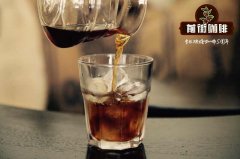Variants of coffee varieties in the world, genetic mutants, pointed bourbon.

Professional coffee knowledge exchange more coffee bean information please follow the coffee workshop (Wechat official account cafe_style)
Coffee variety gene mutant
Pointed Bourbon (Bourbon Pointu): found in Bourbon Island in 1810, beans changed from round to pointed, with only half the caffeine content, but in small amounts, weak and extremely precious (mostly cultivated in the laboratory).
Elephant bean (Maragogype, or Elephant Bean): Tibica's best-known variety of beans, first discovered in 1870 in the Maragogype bean-producing region of the state of Bahia in northeastern Brazil, is at least three times larger than the average Arabica, hence the name. The taste of elephant bean is poor in low altitude area, but it has better flavor at high altitude, mild sour taste and sweet fragrance.
Geisha / Geisha: a derivative of the Tibika family, it was exported from the Geisha Mountains of southern Ethiopia in 1931 (Geisha is synonymous with Japanese geisha). It was unknown in many countries and was transplanted to Panama in the 1960s and did not begin to win cup tests until 2005.
Kenyan "SL28" and "SL34": the bourbon line, screened and cultivated by French and British missionaries and researchers in Kenya in the early 20th century, has adapted to Kenya's high-concentration phosphate soil for a century, giving birth to Kenyan characteristics of sour elves; top Kenyan coffee comes from these two varieties, but it loses its flavor when transplanted elsewhere.
Yellow bourbon (Bourbon Amarello, or YellowBourbon): a bourbon variety endemic to the Brazilian state of Sao Paulo, where the coffee fruit does not turn red and is orange when ripe. It was later found that the pericarp of other local bourbon-derived varieties also turned yellow.
Kaddura (Caturra)
It is a single gene variant of bourbon found in Brazil in the 1950s. It has better yield and disease resistance than bourbon, and the tree is shorter and easy to harvest. Unfortunately, it has the same problem as bourbon-- as a result, it takes a year off for a year. The flavor is equal to or slightly worse than bourbon beans.
But it is more adaptable, can be planted with high density, does not need shade trees, and can be vibrant in direct exposure to the sun, so it is also called "exposed coffee" (Sun Coffee).
Kaddura is suitable for high altitude areas from 700m to 1700 m, but the higher the altitude is, the better the flavor is, and the bean yield is relatively reduced. There are also variants of yellow Kaddura in Central and South America, but the wind rating is not as good as Huang bourbon.
Pacas (Pacas): a bourbon variety found in El Salvador. In 1935, the Salvadoran coffee farmer "Don Alberto Pacas" selected a high-capacity San Ramon bourbon variety to be planted on a farm. In 1956, his coffee tree yielded more fruit than the same kind of coffee tree. Professor "Dr. William Cogwill" of the University of Florida identified this as a genetic mutation in bourbon and named it "Pacas".
Pacas, with its high output and good quality, is popular in Central America. Currently, 68% of El Salvador is bourbon, while Pacas has 29%.
Vera Saatchi (Villa Sarchi): the bourbon variety, first discovered in Costa Rica in the 1960s, often appears on the cup test list of excellence in recent years.
Kona: although planted at an altitude of several hundred meters, Kona from the Big Island of Hawaii, with a mild sea breeze and rich volcanic soil, has an incomparably clean acidity and sweetness. Compared with the blue mountains with higher elevations, it is even worse.
Blue Mountain (BlueMountain): blue Mountain, which is popular all over the world and hard to get a bean, comes from the iron pickup family. Why is Blue Mountain so hot and expensive?! It is mostly because it is contracted by the royal army, and partly because it is not satisfied with soil and water and is in poor condition once it leaves Jamaica. After two hundred years of domestication, Blue Mountain has evolved successfully in Jamaica, and its resistance to fruit rot is better than that of ordinary iron pickups.
END
Important Notice :
前街咖啡 FrontStreet Coffee has moved to new addredd:
FrontStreet Coffee Address: 315,Donghua East Road,GuangZhou
Tel:020 38364473
- Prev

Coffee varieties and producing areas Coffee varieties Tippika Ancient Tibica varieties
Professional coffee knowledge exchange more coffee bean information please follow Coffee Workshop (Wechat official account cafe_style) Coffee variety Typic: Ethiopia's oldest native variety, all Arabica are derived from Tibica. The top leaf of Tiebika is bronzed and the bean body is oval or thin in shape; the flavor is elegant, but the physique is weak, the disease resistance is poor and the fruit yield is less. Jamaica
- Next

The main varieties of coffee are representative varieties of coffee well-known varieties of coffee
Professional coffee knowledge exchange more coffee bean information please follow the coffee workshop (Wechat official account cafe_style) Coffee belongs to the Rubiaceae, the main varieties in circulation are the following two. Arabica (Arabica): higher planting cost, better quality, particularly mellow taste, growing at high altitudes, including Nicaragua, Costa Rica and Bana
Related
- Detailed explanation of Jadeite planting Land in Panamanian Jadeite Manor introduction to the grading system of Jadeite competitive bidding, Red bid, Green bid and Rose Summer
- Story of Coffee planting in Brenka region of Costa Rica Stonehenge Manor anaerobic heavy honey treatment of flavor mouth
- What's on the barrel of Blue Mountain Coffee beans?
- Can American coffee also pull flowers? How to use hot American style to pull out a good-looking pattern?
- Can you make a cold extract with coffee beans? What is the right proportion for cold-extracted coffee formula?
- Indonesian PWN Gold Mandrine Coffee Origin Features Flavor How to Chong? Mandolin coffee is American.
- A brief introduction to the flavor characteristics of Brazilian yellow bourbon coffee beans
- What is the effect of different water quality on the flavor of cold-extracted coffee? What kind of water is best for brewing coffee?
- Why do you think of Rose Summer whenever you mention Panamanian coffee?
- Introduction to the characteristics of authentic blue mountain coffee bean producing areas? What is the CIB Coffee Authority in Jamaica?

